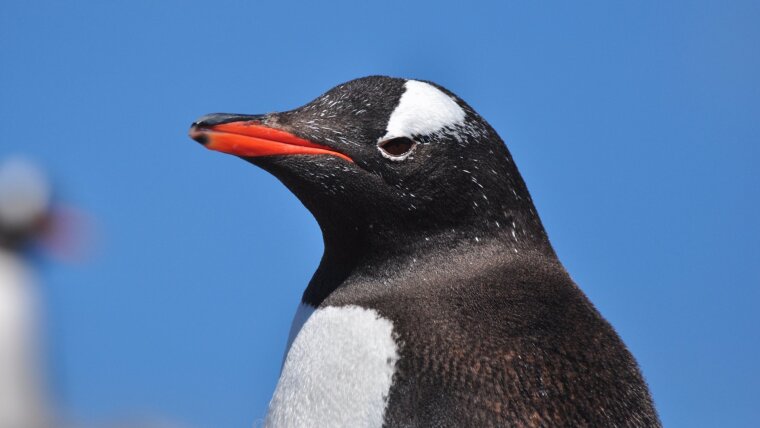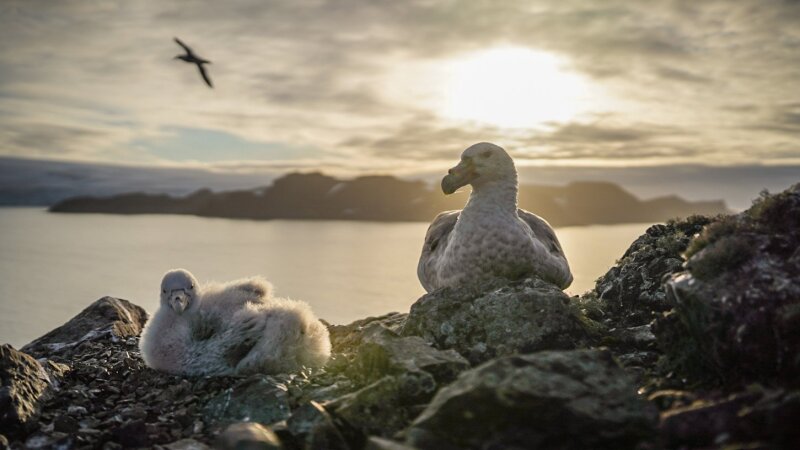
- Research
Published: | By: Ute Schönfelder
If there were ever a prize for the longest journey to work, the Jena University team led by Christina Braun would stand a good chance of winning it. To reach their research area, the polar ornithologist and her team travel some 14,000 kilometres – as the crow flies – each time. Their destination is the Fildes Peninsula on King George Island in the Antarctic. Researchers from the University of Jena have been observing changes in the Antarctic fauna since the early 1980s. Since 2003, their long-term monitoring project, studying breeding birds and seals, has been funded by the German Environment Agency. A few weeks ago, Christina Braun, Hannes Grämer and the students Noëlle Heid and Nora Förster returned to Jena from their latest stay in the Antarctic, and they have now carried out the first analyses of their research data.
During their three-month-long Antarctic trips, the researchers document the occurrence of a total of 14 breeding bird species in a defined area of around 35 km2. These include penguin species, such as the chinstrap, Adélie and gentoo penguins, as well as skuas and giant petrels. “We count the number of breeding pairs and their breeding success, that is to say how many chicks have survived at the end of the season,” says Christina Braun. She has been part of Jena University’s Polar and Bird Ecology working group since 2000 and this year marked her 14th research visit to Antarctica. “This monitoring, over what is now a period of four decades, is unprecedented and our data are an important basis for research,” she notes.
Climate change alters species ratio
The researchers can read clear trends from their observations. For example, cape petrels, which once bred in their hundreds in the research area, have almost completely disappeared. The researchers from Jena only discovered three breeding pairs during this year’s stay. Other species are significantly increasing in numbers, including the giant petrel. “This is due to changing environmental conditions, particularly as a result of climate change,” says Christina Braun. Giant petrels benefit from the warming of the ocean, where they find a more abundant food supply. The researchers also observed similar shifts by penguins. While gentoo penguins, which are originally from sub-Antarctic regions, are spreading ever further, species typical of Antarctica, such as Adélie and chinstrap penguins, are in retreat. “Both species depend on sea ice, as it forms the basis of the Antarctic food chain, with Antarctic krill, the main food source for penguins and whales, grazing on the ice algae that are available there. As the sea ice continues to shrink, the penguins are migrating ever further south, to less suitable areas,” says Braun.
Giant petrel with a chick: Giant petrels are considered an indicator species for environmental changes and for disturbances in the breeding area. They spend most of their lives as scavengers at sea and can reach a wingspan of up to two metres. Giant petrels breed in colonies and lay one egg that is incubated by both parents. After about four months, the chick is fledged or ready to fly.
Image: Hannes GrämerTogether with Uruguayan colleagues, the researchers from Jena have also been involved in monitoring the breeding success of gentoo penguins throughout the Antarctic. “We’ve observed how the animals grow and gain weight,” explains research assistant Hannes Grämer, a member of the Jena expedition team. In practice, this meant catching and weighing 20 young animals every day. While gentoo penguin chicks weigh around 110 grams when they hatch, they reach between 3.5 and 6 kilos at the end of the summer. “Their weight ultimately determines their chances of survival in the winter ahead,” says Grämer, who was on his fourth expedition to the Antarctic.
In the coming months, the researchers will process the data collected during the past season for a new edition of the report entitled “Monitoring der klimabedingten Veränderungen terrestrischer und mariner Ökosysteme in der Maxwell Bay (Antarktis)External link” (Monitoring climate-induced changes in terrestrial and marine ecosystems in Maxwell Bay (Antarctica)), which the Federal Environment Agency publishes every three years. The results will also be published in scientific journals. And after that, it will soon be time to plan the next trip. In November, or December at the latest, the team from Jena will set off again to observe the changes in the Antarctic fauna.
A Gentoo penguin feeds its young. Gentoo penguins are one of three penguin species native to the study area. The resident colony hosts the largest breeding site of this species, which is spreading in Antarctica. Gentoo penguins usually lay two eggs, with incubation and young rearing carried out by both parents. The main diet of gentoo penguins is krill and fish.
Image: Christina Braun